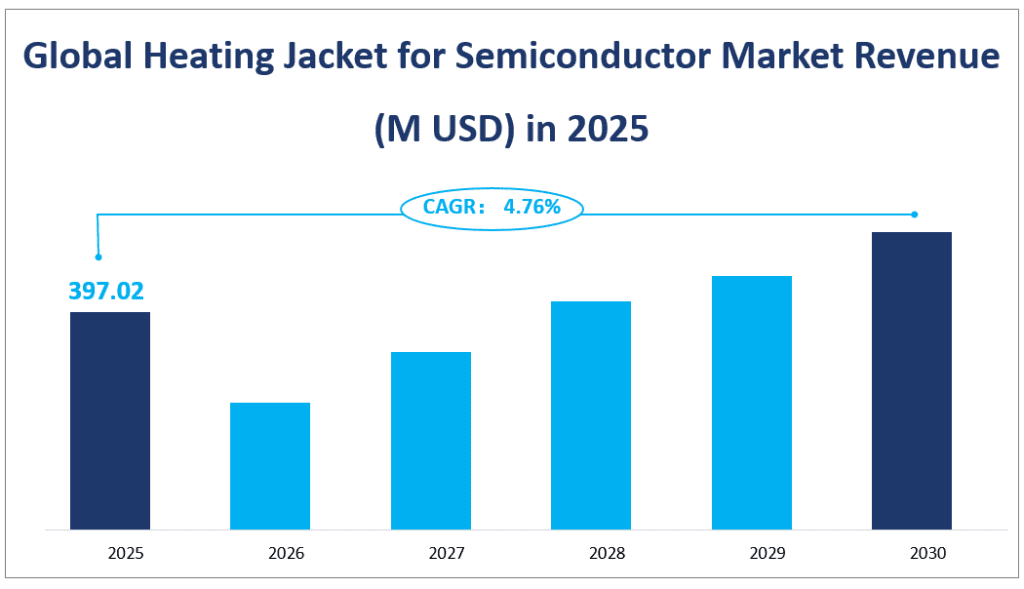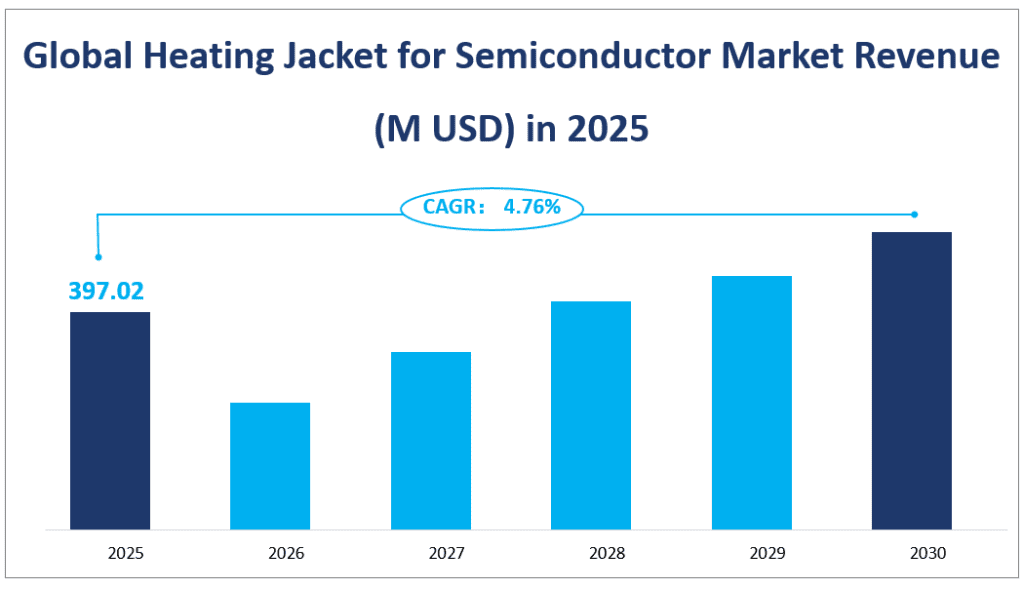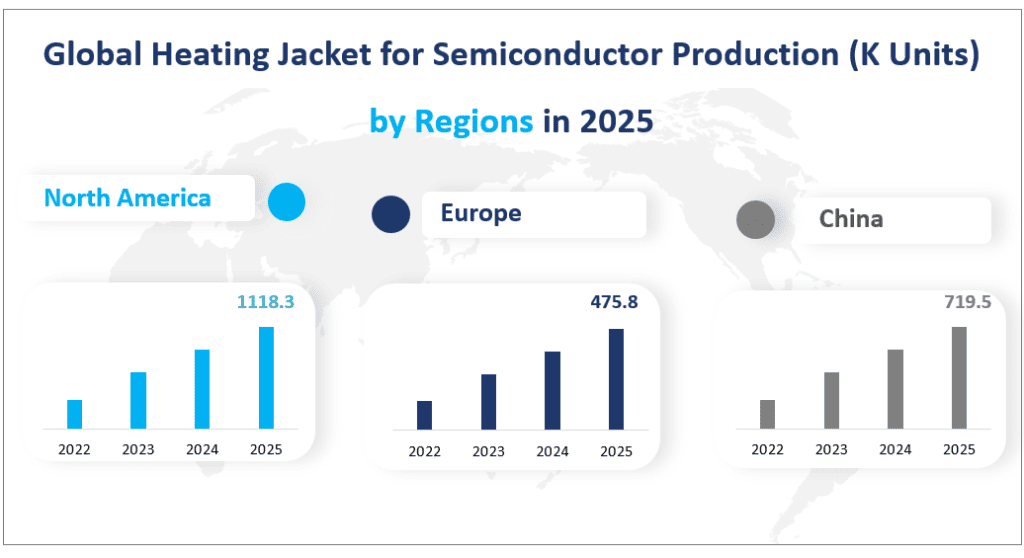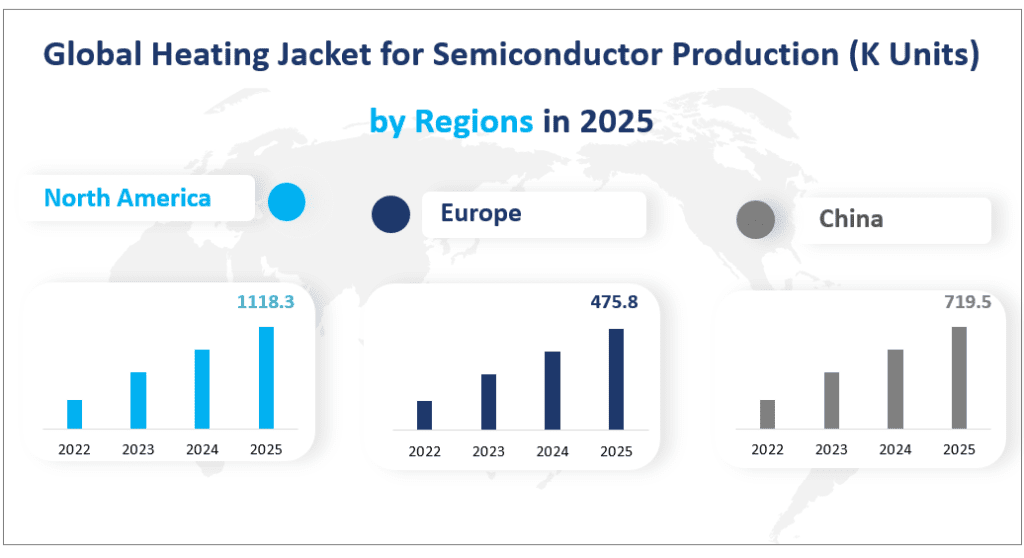1. Global Heating Jacket for Semiconductor Market Revenue
The global Heating Jacket for Semiconductor market is projected to achieve a revenue of $397.02 million with a CAGR of 4.76% from 2025 to 2030. This indicates a steady and robust expansion of the market, as the demand for efficient thermal management solutions in semiconductor manufacturing continues to rise.
A Heating Jacket for Semiconductor is a specialized device designed to provide controlled heating to semiconductor processing systems. These jackets are essential in maintaining optimal temperatures during critical processes such as chemical vapor deposition (CVD) and etching, where temperature control is crucial for the quality and efficiency of semiconductor production. Made from materials like PTFE and silicone rubber, these jackets prevent the build-up of contaminants, reduce maintenance time, and enhance overall process efficiency. They are particularly important in preventing condensation and ensuring uniform temperature distribution in gas lines and vacuum systems.
Global Heating Jacket for Semiconductor Market Revenue (M USD) in 2025


2. Driving Factors of Heating Jacket for Semiconductor Market
The growth of the Heating Jacket for the Semiconductor market is primarily driven by the continuous expansion of the semiconductor industry. As technology advances and the demand for semiconductor chips increases, particularly in sectors such as 5G, artificial intelligence, and automotive electronics, the need for reliable and efficient thermal management solutions becomes more pronounced.
Another key driver is the increasing complexity of semiconductor manufacturing processes. Modern semiconductor production involves highly sensitive and precise operations that require stringent temperature control. Heating jackets play a crucial role in maintaining the integrity of these processes by preventing temperature fluctuations and ensuring uniform heat distribution. This is particularly important in processes such as CVD and etching, where even minor deviations in temperature can lead to significant defects in the final product.
Moreover, the environmental and safety benefits of using heating jackets cannot be overlooked. By preventing the build-up of contaminants and reducing the risk of condensation, these jackets help maintain a clean and safe production environment. This is crucial in semiconductor manufacturing, where even minute impurities can lead to significant quality issues and increased production costs.
3. Limiting Factors of Heating Jacket for the Semiconductor Market
Despite the significant growth potential, the Heating Jacket for Semiconductor market faces several challenges that could limit its expansion. One of the primary concerns is the fluctuation in raw material prices. The production of heating jackets relies heavily on materials such as PTFE and silicone rubber, which are subject to market price volatility. Sudden increases in raw material costs can significantly impact the profitability of manufacturers, especially if they are unable to pass these costs on to their customers.
Another limiting factor is the high concentration of customers in the semiconductor industry. The market is heavily reliant on a few major semiconductor manufacturers, and any significant changes in their operations or purchasing patterns can have a substantial impact on the market. For instance, if a major semiconductor manufacturer decides to switch to an alternative thermal management solution or reduces its production capacity, it could lead to a decline in demand for heating jackets.
Additionally, the market faces competition from alternative technologies and solutions. As the semiconductor industry evolves, new and more efficient thermal management technologies may emerge, potentially displacing traditional heating jackets. This requires manufacturers to continuously innovate and improve their products to stay competitive in the market.
4. Heating Jacket for Semiconductor Market Segment
Product Types
Teflon (PTFE) Heater Jackets are anticipated to generate a revenue of $171.11 million in 2025. These jackets are highly valued for their chemical resistance, non-stick properties, and ability to withstand high temperatures, making them ideal for semiconductor manufacturing processes where purity and precision are paramount. PTFE jackets are particularly effective in preventing contamination and ensuring uniform heat distribution, which are critical factors in processes such as chemical vapor deposition (CVD) and etching.
Silicone Rubber Heater Jackets are expected to achieve a revenue of $181.15 million in 2025. Silicone rubber is known for its flexibility, durability, and resistance to extreme temperatures, making it a popular choice for applications that require frequent adjustments or handling. These jackets are often used in semiconductor equipment where flexibility and ease of installation are essential. Silicone rubber jackets also provide excellent insulation, reducing the risk of heat loss and ensuring efficient energy use.
Other types of heating jackets, which include fiberglass and other materials, are projected to generate a revenue of $44.76 million in 2025. These alternative materials offer unique advantages depending on the specific requirements of the manufacturing process. For instance, fiberglass jackets are known for their high thermal conductivity and mechanical strength, making them suitable for applications where robustness and heat transfer efficiency are critical.
In terms of market share, Silicone Rubber Heater Jackets are expected to hold the largest share in 2025, accounting for approximately 47.63% of the total market revenue. This dominance is attributed to the widespread use of silicone rubber jackets in various semiconductor manufacturing processes due to their flexibility, durability, and ease of installation.
Market by Applications
Semiconductor FABs are expected to consume 2,285.5 thousand units of heating jackets in 2025. These facilities are the epicenters of semiconductor manufacturing, where integrated circuits and other semiconductor devices are produced. The use of heating jackets in FABs is essential for maintaining optimal temperatures during critical processes such as Chemical Vapor Deposition (CVD), etching, and photolithography. These jackets help prevent contamination, reduce maintenance time, and ensure uniform temperature distribution, which is crucial for the high-quality production of semiconductor devices.
Semiconductor Equipment Manufacturers are projected to consume 724.8 thousand units in 2025. These manufacturers produce the equipment used in semiconductor production, such as vacuum pumps, gas delivery systems, and exhaust lines. Heating jackets are widely used in this segment to ensure that equipment operates efficiently and safely. By maintaining consistent temperatures and preventing condensation, these jackets help extend the lifespan of the equipment and reduce downtime.
In terms of market share, Semiconductor FABs are expected to hold the largest share in 2025, accounting for approximately 75.92% of the total market consumption. This dominance is due to the critical role that heating jackets play in the day-to-day operations of semiconductor manufacturing plants, where temperature control is essential for maintaining process efficiency and product quality.
Market Revenue and Share by Segment
| Market Revenue (M USD) in 2025 | Market Share in 2025 | ||
| By Type | Teflon (PTFE) Heater Jacket | 171.11 | 43.10% |
| Silicone Rubber Heater Jacket | 181.15 | 45.63% | |
| Others | 44.76 | 11.27% | |
| Consumption (K Units) in 2025 | Market Share in 2025 | ||
| By Application | Semiconductor FAB | 2285.5 | 75.92% |
| Semiconductor Equipment Manufacturers | 724.8 | 24.08% |
5. Regional Heating Jacket for Semiconductor Market
North America is projected to be a major player in the production of heating jacket for semiconductors, with an estimated production volume of 1,118.3 thousand units in 2025. The region benefits from a robust industrial base, advanced manufacturing capabilities, and a strong presence of leading semiconductor companies. The United States, in particular, is a hub for semiconductor manufacturing and research, driving the demand for high-quality heating jackets. The growth in North America is further supported by government initiatives and investments in the semiconductor industry, such as the US Chip and Science Act, which aims to boost domestic production capabilities.
Europe is another significant region, with an estimated production of 475.8 thousand units in 2025. European countries like Germany, France, and the UK have a long history of semiconductor manufacturing and are home to several key players in the industry. The region’s strength lies in its advanced technology, skilled workforce, and strong research and development capabilities. Europe’s production growth is driven by the increasing demand for semiconductors in automotive electronics, industrial control, and other high-tech sectors.
China is expected to be the largest regional market by production volume, with an estimated 719.5 thousand units in 2025. China’s rapid industrialization, government support for the semiconductor industry, and the growing domestic demand for electronic products have positioned it as a global leader in semiconductor manufacturing. The Chinese government’s “Made in China 2025” initiative aims to enhance the country’s technological capabilities and reduce dependence on foreign semiconductor chips. This has led to significant investments in semiconductor manufacturing facilities, driving the demand for heating jackets and other thermal management solutions.
Japan is also a key region, with an estimated production of 229.9 thousand units in 2025. Japan has a strong reputation for high-quality semiconductor manufacturing and advanced technology. Companies like TSMC Japan and other major semiconductor players have a significant presence in the country, driving the demand for heating jackets. Japan’s production growth is supported by its focus on innovation and continuous improvement in manufacturing processes.
Other regions, including Southeast Asia, Latin America, and the Middle East, are also contributing to the global production of heating jacket for semiconductors. These regions are expected to produce a combined total of 466.9 thousand units in 2025. The growth in these regions is driven by the increasing adoption of semiconductor technologies in various industries and the expansion of manufacturing capabilities.
Global Heating Jacket for Semiconductor Production (K Units) by Regions in 2025


6. Top 3 Companies in the Heating Jacket for Semiconductor Market
BriskHeat
Company Introduction and Business Overview: BriskHeat, established in 1949, is a global leader in the manufacturing of flexible surface heating elements, controls, and accessories. The company has a strong presence in North America, Asia Pacific, and Europe, with manufacturing facilities in the United States and Vietnam. BriskHeat specializes in solving viscosity control, condensation prevention, process heating, and freeze protection applications across various industries.
Products Offered: BriskHeat offers a wide range of heating jackets, including custom cloth heating jackets designed for outdoor, indoor, and wash-down environments. These jackets are water-resistant and provide both heat and insulation, making them suitable for a variety of applications such as viscosity control, freeze protection, and temperature maintenance.
In 2022, BriskHeat reported a revenue of $34.01 million.
Watlow (CRC)
Company Introduction and Business Overview: Watlow, established in 1922, is a global technology and manufacturing leader in thermal products and systems. The company operates in North America, Europe, and Asia, with a strong focus on delivering innovative thermal solutions for various industries, including semiconductor processing, environmental chambers, and energy processing.
Products Offered: Watlow’s product portfolio includes ASSURANT™ heater jackets, which are designed for downstream exhaust line applications in semiconductor manufacturing. These jackets provide efficient, easy-to-install heating solutions with high-temperature capabilities and minimal particle generation.
In 2022, Watlow reported a revenue of $26.40 million.
MKS Instruments
Company Introduction and Business Overview: MKS Instruments, established in 1961, is a global provider of technology-based solutions for semiconductor manufacturing, advanced electronics, and specialized industrial applications. The company is headquartered in the United States and operates worldwide, offering a range of instruments, systems, and process control solutions.
Products Offered: MKS Instruments offers a variety of heating jackets designed for vacuum tubing and assemblies. These jackets are compatible with cleanroom environments and provide secure fit and efficient heating solutions for semiconductor manufacturing processes.
In 2022, MKS Instruments reported a revenue of $18.31 million.
Major Players
| Company Name | Plant Locations | Market Distribution |
| BriskHeat | Mainly in the United States, Vietnam | Mainly in North America, Asia Pacific, and Europe |
| Watlow (CRC) | Mainly in North America, Europe, and Asia | Worldwide |
| MKS Instruments | Mainly in the United States | Worldwide |
| Krosaki Harima Corporation | Mainly in Japan | Mainly in Asia, Europe, and North America |
| BoBoo | Mainly in South Korea | Mainly in Asia Pacific, North America, Europe |
| YES Heating Technix Co., Ltd | South Korea | Worldwide |
| Pfeiffer Vacuum Valves & Engineering | Mainly in Europe, the United States, and Asia | Worldwide |
| Hefei ASH Semiconductor Equipment Technology | China | Mainly in Asia Pacific |
| Backer AB | Mainly in Europe | Mainly in Europe, North America, Asia |
| MOL Mechanical & Electronic (Wuxi) Co., Ltd | China | Mainly in Asia Pacific |
| Jiangyin Huilong | Mainly in China | Mainly in Asia Pacific, North America, Europe |
| Benchmark Thermal | Mainly in the United States | Mainly in North America, Europe, Asia |
| FINE Co., Ltd. | South Korea | Mainly in Asia Pacific |
| TGM Incorporated | United States | Mainly in North America |
| ISO HEAT | Germany | Mainly in Europe |
| Global Lab Co., Ltd. | Mainly in South Korea | Mainly in Asia Pacific |
| WIZTEC | Mainly in South Korea | Mainly in Asia Pacific |
1 Heating Jacket for Semiconductor Market Overview
1.1 Product Overview and Scope of Heating Jacket for Semiconductor
1.2 Heating Jacket for Semiconductor Segment by Type
1.2.1 Global Heating Jacket for Semiconductor Market Size Growth Rate Analysis by Type 2022 VS 2028
1.2.2 Teflon (PTFE) Heater Jacket
1.2.3 Silicone Rubber Heater Jacket
1.3 Heating Jacket for Semiconductor Segment by Applications
1.3.1 Heating Jacket for Semiconductor Consumption Comparison by Application: 2017 VS 2022 VS 2028
1.4 Global Market Size and Growth Prospects (2017-2028)
1.4.1 Global Heating Jacket for Semiconductor Revenue Estimates and Forecasts (2017-2028)
1.4.2 Global Heating Jacket for Semiconductor Production Estimates and Forecasts (2017-2028)
1.5 Global Heating Jacket for Semiconductor Market by Region
1.5.1 Global Heating Jacket for Semiconductor Market Size Estimates and Forecasts by Region: 2017 VS 2022 VS 2028
1.5.2 North America Heating Jacket for Semiconductor Estimates and Forecasts (2017-2028)
1.5.3 Europe Heating Jacket for Semiconductor Estimates and Forecasts (2017-2028)
1.5.4 China Heating Jacket for Semiconductor Estimates and Forecasts (2017-2028)
1.5.5 Japan Heating Jacket for Semiconductor Estimates and Forecasts (2017-2028)
2 Market Competition by Manufacturers
2.1 Global Heating Jacket for Semiconductor Production Market Share by Manufacturer
2.2 Global Heating Jacket for Semiconductor Revenue Market Share by Manufacturer (2017-2022)
2.3 Heating Jacket for Semiconductor Market Share by Company Type (Tier 1, Tier 2 and Tier 3)
2.4 Global Heating Jacket for Semiconductor Average Price by Manufacturers (2017-2022)
2.5 Manufacturers Heating Jacket for Semiconductor Production Sites, Area Served
2.6 Heating Jacket for Semiconductor Market Competitive Situation and Trends
2.6.1 Heating Jacket for Semiconductor Market Concentration Rate
2.6.2 Global Top 5 and Top 10 Players Market Share by Revenue
2.6.3 Mergers & Acquisitions, Expansion
3 Production by Region
3.1 Global Production of Heating Jacket for Semiconductor by Regions (2017-2022)
3.2 Global Heating Jacket for Semiconductor Revenue and Market Share by Regions
3.3 Global Heating Jacket for Semiconductor Production, Revenue, Price and Gross Margin (2017-2022)
3.4 North America Heating Jacket for Semiconductor Production
3.4.1 North America Heating Jacket for Semiconductor Production Growth Rate (2017-2022)
3.4.2 North America Heating Jacket for Semiconductor Production, Revenue, Price and Gross Margin (2017-2022)
3.5 Europe Heating Jacket for Semiconductor Production
3.5.1 Europe Heating Jacket for Semiconductor Production Growth Rate (2017-2022)
3.5.2 Europe Heating Jacket for Semiconductor Production, Revenue, Price and Gross Margin (2017-2022)
3.6 China Heating Jacket for Semiconductor Production
3.6.1 China Heating Jacket for Semiconductor Production Growth Rate (2017-2022)
3.6.2 China Heating Jacket for Semiconductor Production, Revenue, Price and Gross Margin (2017-2022)
3.7 Japan Heating Jacket for Semiconductor Production
3.7.1 Japan Heating Jacket for Semiconductor Production Growth Rate (2017-2022)
3.7.2 Japan Heating Jacket for Semiconductor Production, Revenue, Price and Gross Margin (2017-2022)
4 Global Heating Jacket for Semiconductor Consumption by Region
4.1 Global Heating Jacket for Semiconductor Consumption by Regions
4.1.1 Global Heating Jacket for Semiconductor Consumption by Region
4.1.2 Global Heating Jacket for Semiconductor Consumption Market Share by Region
4.2 North America
4.2.1 North America Heating Jacket for Semiconductor Consumption by Country
4.2.2 U.S.
4.2.3 Canada
4.3 Europe
4.3.1 Europe Heating Jacket for Semiconductor Consumption by Country
4.3.2 Germany
4.3.3 France
4.3.4 U.K.
4.3.5 Italy
4.3.6 Russia
4.4 Asia Pacific
4.4.1 Asia Pacific Heating Jacket for Semiconductor Consumption by Region
4.4.2 China
4.4.3 Japan
4.4.4 South Korea
4.4.5 Southeast Asia
4.5 Latin America
4.5.1 Latin America Heating Jacket for Semiconductor Consumption by Country
4.5.2 Mexico
4.5.3 Brazil
5 Production, Revenue, Price Trend by Type
5.1 Global Heating Jacket for Semiconductor Production and Market Share by Type (2017-2022)
5.2 Global Heating Jacket for Semiconductor Revenue Market Share by Type (2017-2022)
5.3 Global Heating Jacket for Semiconductor Price by Type (2017-2022)
6 Consumption by Application
6.1 Global Heating Jacket for Semiconductor Consumption Market Share by Applications (2017-2022)
6.2 Global Heating Jacket for Semiconductor Consumption Growth Rate by Application (2017-2022)
7 Key Companies Profiled
7.1 BriskHeat
7.1.1 BriskHeat Heating Jacket for Semiconductor Corporation Information
7.1.2 BriskHeat Main Business and Markets Served
7.1.3 Heating Jacket for Semiconductor Product Portfolio
7.1.4 BriskHeat Heating Jacket for Semiconductor Production, Revenue, Price and Gross Margin (2017-2022)
7.1.5 BriskHeat Recent Developments/Updates
7.2 Watlow (CRC)
7.2.1 Watlow (CRC) Heating Jacket for Semiconductor Corporation Information
7.2.2 Watlow (CRC) Main Business and Markets Served
7.2.3 Heating Jacket for Semiconductor Product Portfolio
7.2.4 Watlow (CRC) Heating Jacket for Semiconductor Production, Revenue, Price and Gross Margin (2017-2022)
7.2.5 Watlow (CRC) Recent Developments/Updates
7.3 MKS Instruments
7.3.1 MKS Instruments Heating Jacket for Semiconductor Corporation Information
7.3.2 MKS Instruments Main Business and Markets Served
7.3.3 Heating Jacket for Semiconductor Product Portfolio
7.3.4 MKS Instruments Heating Jacket for Semiconductor Production, Revenue, Price and Gross Margin (2017-2022)
7.3.5 MKS Instruments Recent Developments/Updates
7.4 Krosaki Harima Corporation
7.4.1 Krosaki Harima Corporation Heating Jacket for Semiconductor Corporation Information
7.4.2 Krosaki Harima Corporation Main Business and Markets Served
7.4.3 Heating Jacket for Semiconductor Product Portfolio
7.4.4 Krosaki Harima Corporation Heating Jacket for Semiconductor Production, Revenue, Price and Gross Margin (2017-2022)
7.5 BoBoo
7.5.1 BoBoo Heating Jacket for Semiconductor Corporation Information
7.5.2 BoBoo Main Business and Markets Served
7.5.3 Heating Jacket for Semiconductor Product Portfolio
7.5.4 BoBoo Heating Jacket for Semiconductor Production, Revenue, Price and Gross Margin (2017-2022)
7.6 YES Heating Technix Co., Ltd
7.6.1 YES Heating Technix Co., Ltd Heating Jacket for Semiconductor Corporation Information
7.6.2 YES Heating Technix Co., Ltd Main Business and Markets Served
7.6.3 Heating Jacket for Semiconductor Product Portfolio
7.6.4 YES Heating Technix Co., Ltd Heating Jacket for Semiconductor Production, Revenue, Price and Gross Margin (2017-2022)
7.7 Pfeiffer Vacuum Valves & Engineering
7.7.1 Pfeiffer Vacuum Valves & Engineering Heating Jacket for Semiconductor Corporation Information
7.7.2 Pfeiffer Vacuum Valves & Engineering Main Business and Markets Served
7.7.3 Heating Jacket for Semiconductor Product Portfolio
7.7.4 Pfeiffer Vacuum Valves & Engineering Heating Jacket for Semiconductor Production, Revenue, Price and Gross Margin (2017-2022)
7.7.5 Pfeiffer Vacuum Valves & Engineering Recent Developments/Updates
7.8 Hefei ASH Semiconductor Equipment Technology
7.8.1 Hefei ASH Semiconductor Equipment Technology Heating Jacket for Semiconductor Corporation Information
7.8.2 Hefei ASH Semiconductor Equipment Technology Main Business and Markets Served
7.8.3 Heating Jacket for Semiconductor Product Portfolio
7.8.4 Hefei ASH Semiconductor Equipment Technology Heating Jacket for Semiconductor Production, Revenue, Price and Gross Margin (2017-2022)
7.9 Backer AB
7.9.1 Backer AB Heating Jacket for Semiconductor Corporation Information
7.9.2 Backer AB Main Business and Markets Served
7.9.3 Heating Jacket for Semiconductor Product Portfolio
7.9.4 Backer AB Heating Jacket for Semiconductor Production, Revenue, Price and Gross Margin (2017-2022)
7.10 MOL Mechanical & Electronic(Wuxi) Co.,Ltd
7.10.1 MOL Mechanical & Electronic(Wuxi) Co.,Ltd Heating Jacket for Semiconductor Corporation Information
7.10.2 MOL Mechanical & Electronic(Wuxi) Co.,Ltd Main Business and Markets Served
7.10.3 Heating Jacket for Semiconductor Product Portfolio
7.10.4 MOL Mechanical & Electronic(Wuxi) Co.,Ltd Heating Jacket for Semiconductor Production, Revenue, Price and Gross Margin (2017-2022)
7.11 Jiangyin Huilong
7.11.1 Jiangyin Huilong Heating Jacket for Semiconductor Corporation Information
7.11.2 Jiangyin Huilong Main Business and Markets Served
7.11.3 Heating Jacket for Semiconductor Product Portfolio
7.11.4 Jiangyin Huilong Heating Jacket for Semiconductor Production, Revenue, Price and Gross Margin (2017-2022)
7.12 Benchmark Thermal
7.12.1 Benchmark Thermal Heating Jacket for Semiconductor Corporation Information
7.12.2 Benchmark Thermal Main Business and Markets Served
7.12.3 Heating Jacket for Semiconductor Product Portfolio
7.12.4 Benchmark Thermal Heating Jacket for Semiconductor Production, Revenue, Price and Gross Margin (2017-2022)
7.13 FINE Co., Ltd.
7.13.1 FINE Co., Ltd. Heating Jacket for Semiconductor Corporation Information
7.13.2 FINE Co., Ltd. Main Business and Markets Served
7.13.3 Heating Jacket for Semiconductor Product Portfolio
7.13.4 FINE Co., Ltd. Heating Jacket for Semiconductor Production, Revenue, Price and Gross Margin (2017-2022)
7.14 TGM Incorporated
7.14.1 TGM Incorporated Heating Jacket for Semiconductor Corporation Information
7.14.2 TGM Incorporated Main Business and Markets Served
7.14.3 Heating Jacket for Semiconductor Product Portfolio
7.14.4 TGM Incorporated Heating Jacket for Semiconductor Production, Revenue, Price and Gross Margin (2017-2022)
7.15 ISO HEAT
7.15.1 ISO HEAT Heating Jacket for Semiconductor Corporation Information
7.15.2 ISO HEAT Main Business and Markets Served
7.15.3 Heating Jacket for Semiconductor Product Portfolio
7.15.4 ISO HEAT Heating Jacket for Semiconductor Production, Revenue, Price and Gross Margin (2017-2022)
7.16 Global Lab Co., Ltd.
7.16.1 Global Lab Co., Ltd. Heating Jacket for Semiconductor Corporation Information
7.16.2 Global Lab Co., Ltd. Main Business and Markets Served
7.16.3 Heating Jacket for Semiconductor Product Portfolio
7.16.4 Global Lab Co., Ltd. Heating Jacket for Semiconductor Production, Revenue, Price and Gross Margin (2017-2022)
7.17 WIZTEC
7.17.1 WIZTEC Heating Jacket for Semiconductor Corporation Information
7.17.2 WIZTEC Main Business and Markets Served
7.17.3 Heating Jacket for Semiconductor Product Portfolio
7.17.4 WIZTEC Heating Jacket for Semiconductor Production, Revenue, Price and Gross Margin (2017-2022)
8 Heating Jacket for Semiconductor Manufacturing Cost Analysis
8.1 Heating Jacket for Semiconductor Key Raw Materials Analysis
8.1.1 Key Raw Materials
8.1.2 Key Raw Materials Price Trend
8.1.3 Key Suppliers of Raw Materials
8.2 Proportion of Manufacturing Cost Structure
8.2.1 Raw Materials
8.2.2 Labor Cost of Heating Jacket for Semiconductor
8.2.3 Manufacturing Expenses
8.3 Manufacturing Process Analysis of Heating Jacket for Semiconductor
8.4 Heating Jacket for Semiconductor Industrial Chain Analysis
9 Marketing Channel, Distributors and Customers
9.1 Marketing Channel
9.1.1 Direct Channel
9.1.2 Indirect Channel
9.2 Heating Jacket for Semiconductor Distributors List
9.3 Heating Jacket for Semiconductor Customers
10 Market Dynamics
10.1 Heating Jacket for Semiconductor Industry Trends
10.2 Heating Jacket for Semiconductor Growth Drivers
10.3 Heating Jacket for Semiconductor Market Challenges
10.4 Heating Jacket for Semiconductor Market Restraints
10.5 Influence Factors
11 Production and Supply Forecast
11.1 Global Forecasted Production of Heating Jacket for Semiconductor by Region (2023-2028)
11.2 North America Heating Jacket for Semiconductor Production, Revenue Forecast (2023-2028)
11.3 Europe Heating Jacket for Semiconductor Production, Revenue Forecast (2023-2028)
11.4 China Heating Jacket for Semiconductor Production, Revenue Forecast (2023-2028)
11.5 Japan Heating Jacket for Semiconductor Production, Revenue Forecast (2023-2028)
12 Consumption and Demand Forecast
12.1 Global Forecasted Demand of Heating Jacket for Semiconductor
12.2 North America Consumption of Heating Jacket for Semiconductor by Country
12.3 Europe Consumption of Heating Jacket for Semiconductor by Country
12.4 Asia Pacific Heating Jacket for Semiconductor Consumption of Heating Jacket for Semiconductor by Country
12.5 Latin America Heating Jacket for Semiconductor Consumption of Heating Jacket for Semiconductor by Country
13 Forecast by Type and by Application (2023-2028)
13.1 Global Production, Revenue and Price Forecast by Type (2023-2028)
13.1.1 Global Forecasted Production of Heating Jacket for Semiconductor by Type (2023-2028)
13.1.2 Global Forecasted Revenue of Heating Jacket for Semiconductor by Type (2023-2028)
13.1.3 Global Forecasted Price of Heating Jacket for Semiconductor by Type (2023-2028)
13.2 Global Forecasted Consumption of Heating Jacket for Semiconductor by Application (2023-2028)
14 Research Findings and Conclusion
15 Appendix
15.1 Methodology
15.2 Research Data Source
15.2.1 Secondary Data
15.2.2 Primary Data
15.2.3 Market Size Estimation
15.2.4 Legal Disclaimer
15.2.5 Unit Explanation in This Report
